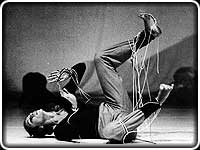|

The
tropics have always fascinated the composer. Numerous business trips have led
him to Brazil, Chile, Columbia and Venezuela. During a stay in the latter
country in the beginning of the '60's he rather suddenly discovered a love for
Los Roques, a small atoll about a mile away from La Guayra, the harbour of
Caracas. The casual way of life in this paradise at the end of the world and
being alone with nature stimulated him to write “Diario marino” (diary of the
sea).
This
“danced adventure” written between 1971 and 1977 falls in line with his other
compositions influenced by the tropics: “Mass for the Nyondo Mission” and
“Viaggio e finale” (Cantata for Tenor and Orchestra based on the exploration
note, “Adventure in Guyana”, by Raymond Maufrais).
As
the French explorer who departed to discover the source of the Maroni River and
disappeared under mysterious circumstances, the hero of “Diario marino” also
leaves an unfinished diary containing his impressions from day to day.
As
sole survivor of a shipwreck he is stranded on an atoll. He reports about his
Robinson-Crusoe-life
and lets us share his enthusiasm for the world surrounding him here midst the
pink flamingoes, tucas, flying fish and giant turtles.
“Exploration
is for me an adventure of purity and humility”.
Alberto
Bruni Tedeschi used this thought of Maufrais's as the introduction of the score
for “Viaggio e finale”. It could apply equally as well to “Diario marino”. Here
the composer, who also wrote the textbook, identifies himself fully with the
stranded man in his fascinated rediscovery of nature. “Diario marino” is a
dream diary of a sailor shortly before his death. He is the type of sailor, as
living in us all, to whom the sea is a place symbolic of eternal return.
The
musical handwriting is decidedly atonal. It rejects any serial or thematic
system.
“Diario
marino” is written for a large orchestra with strongly developed percussion
instrumentation (4 kettle drums, piano, harp, electronic organ, vibraphone,
celesta, glockenspiel, 2 drums, 3 bongos, 3 tam-tams, cymbals, wood blocks, temple
blocks, maracas and triangle).
|
